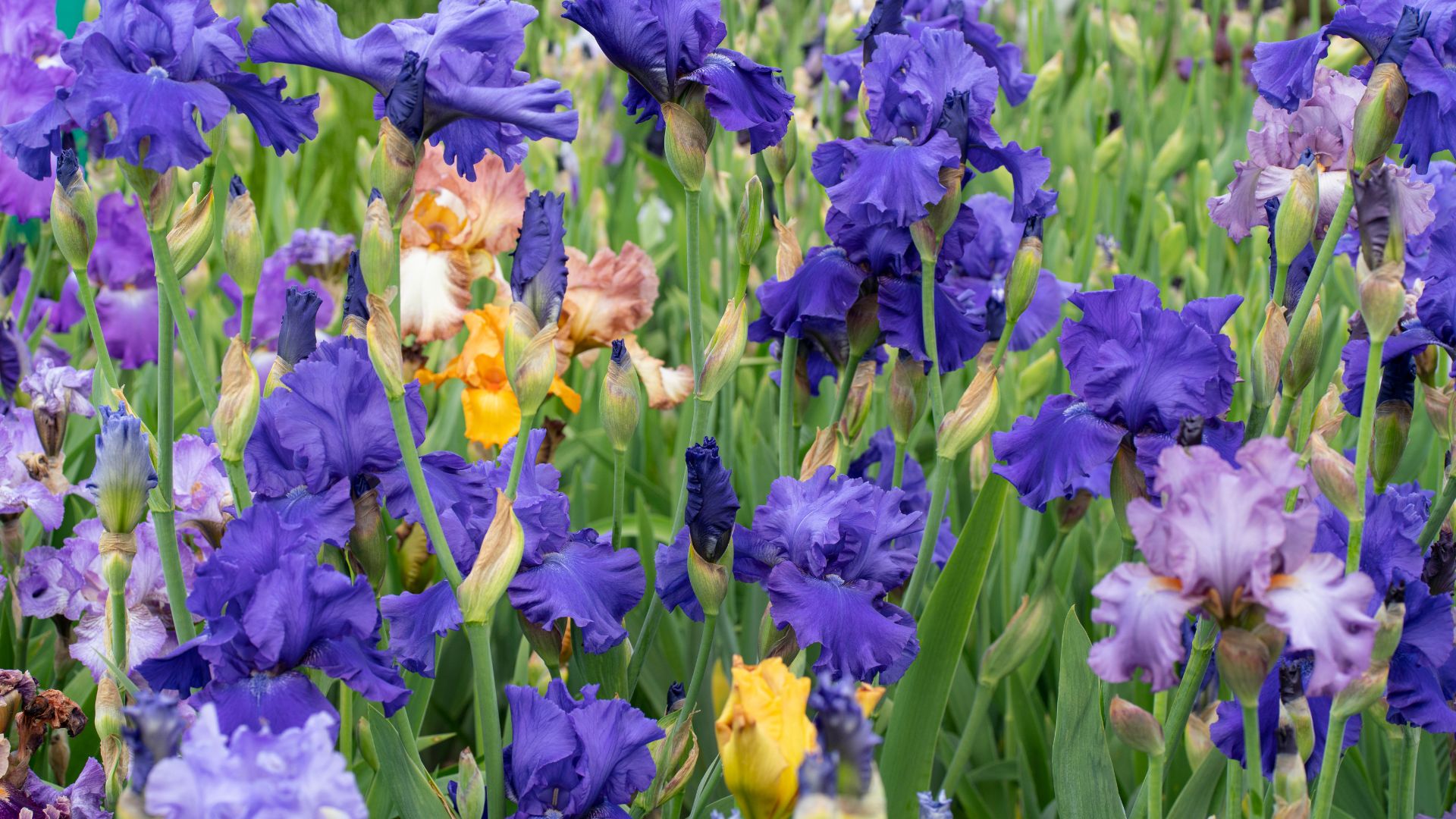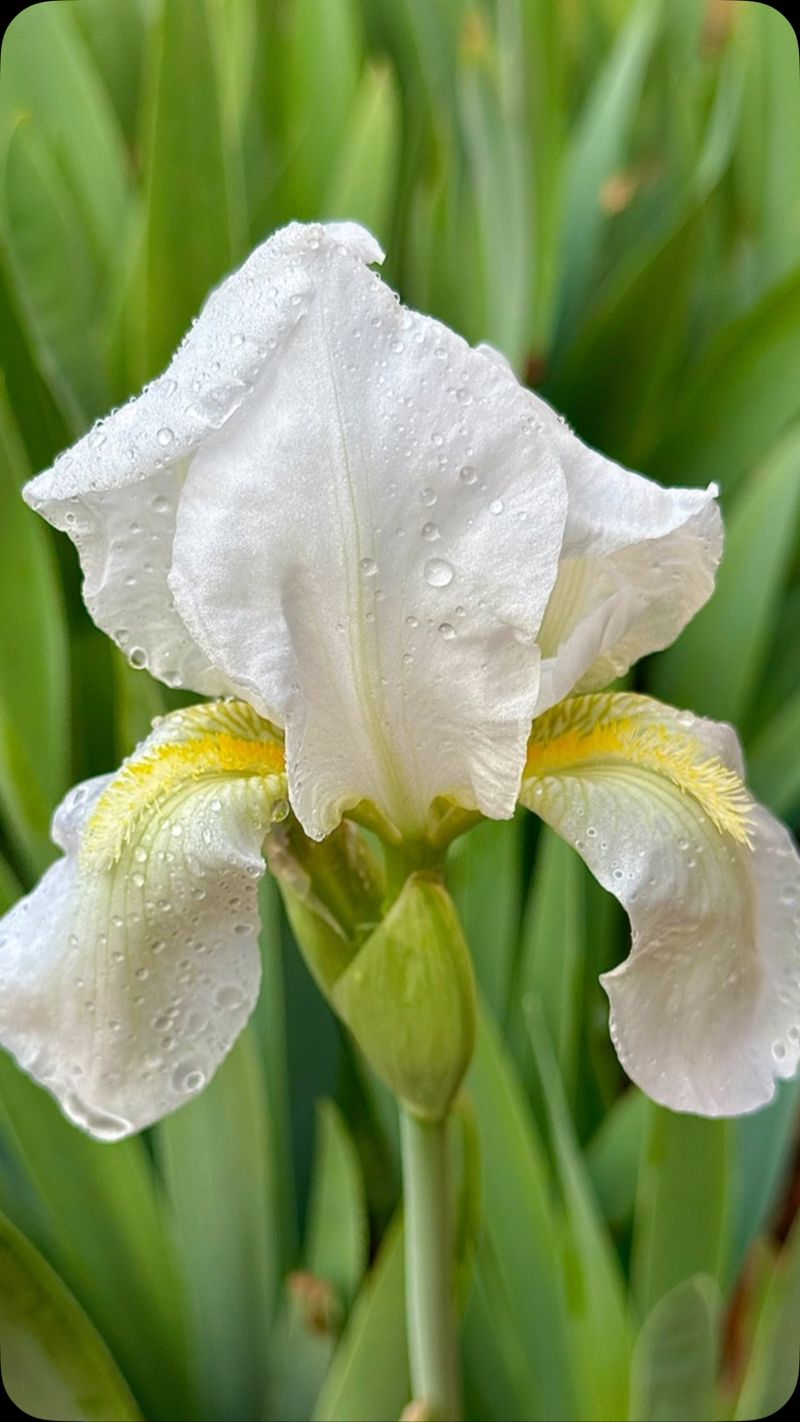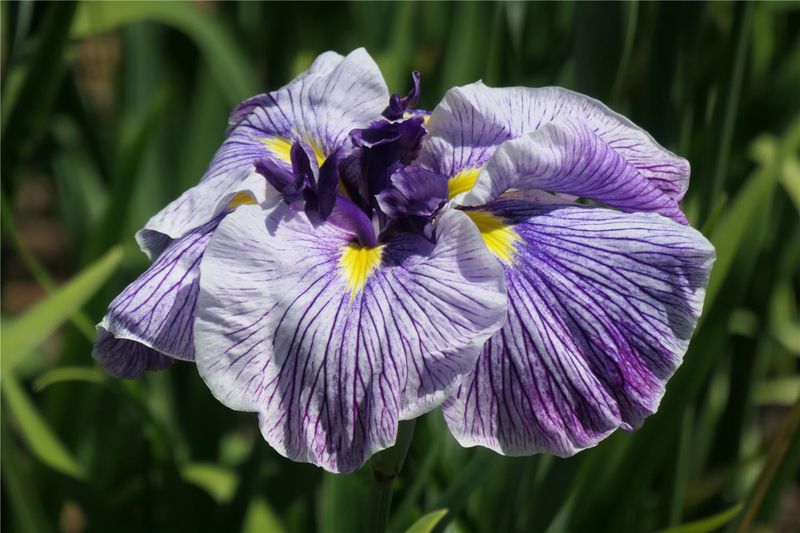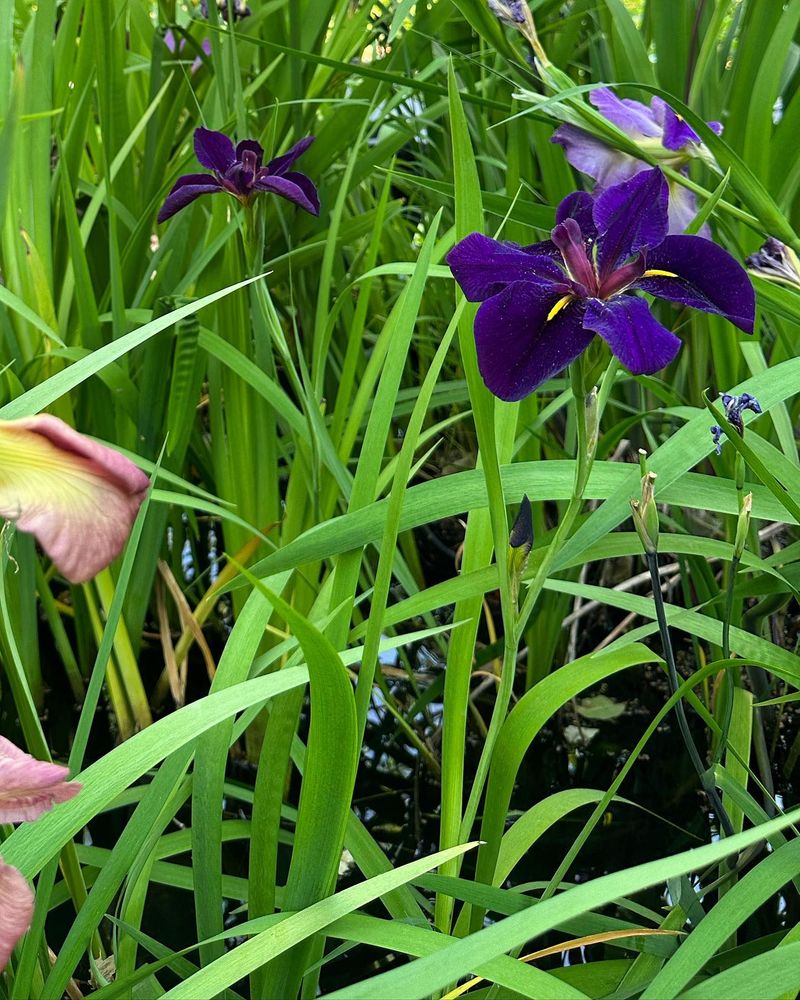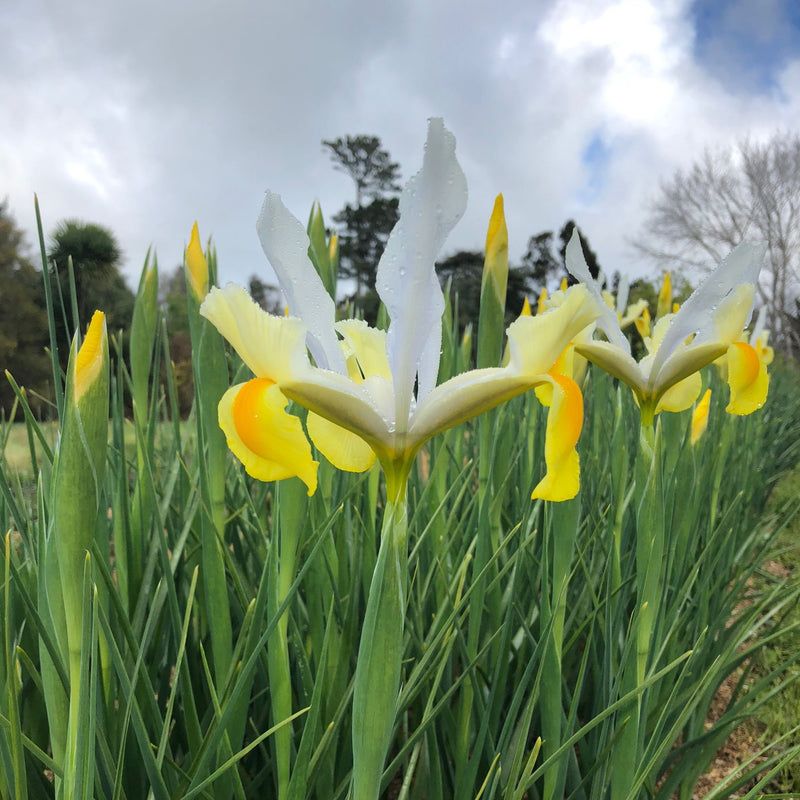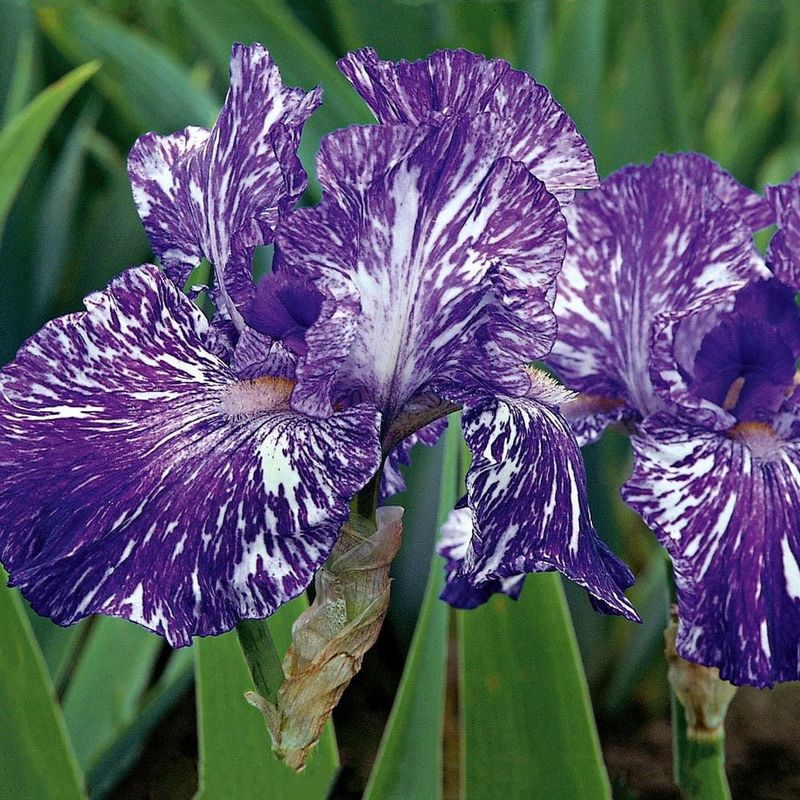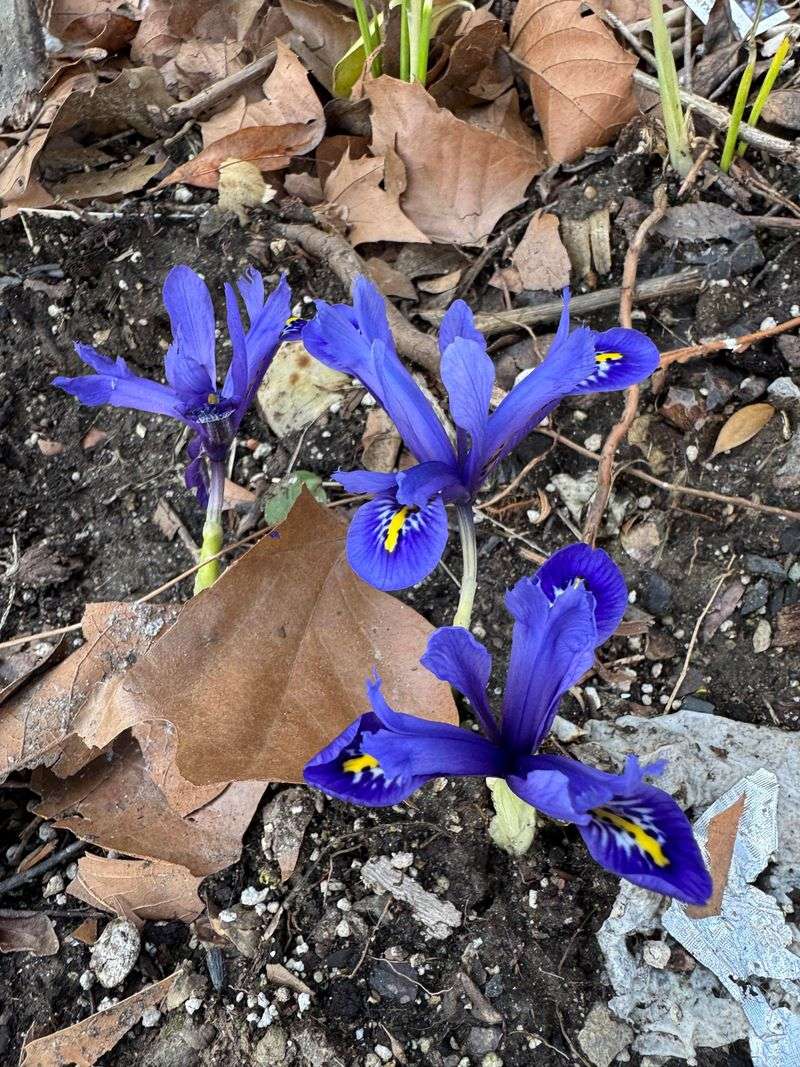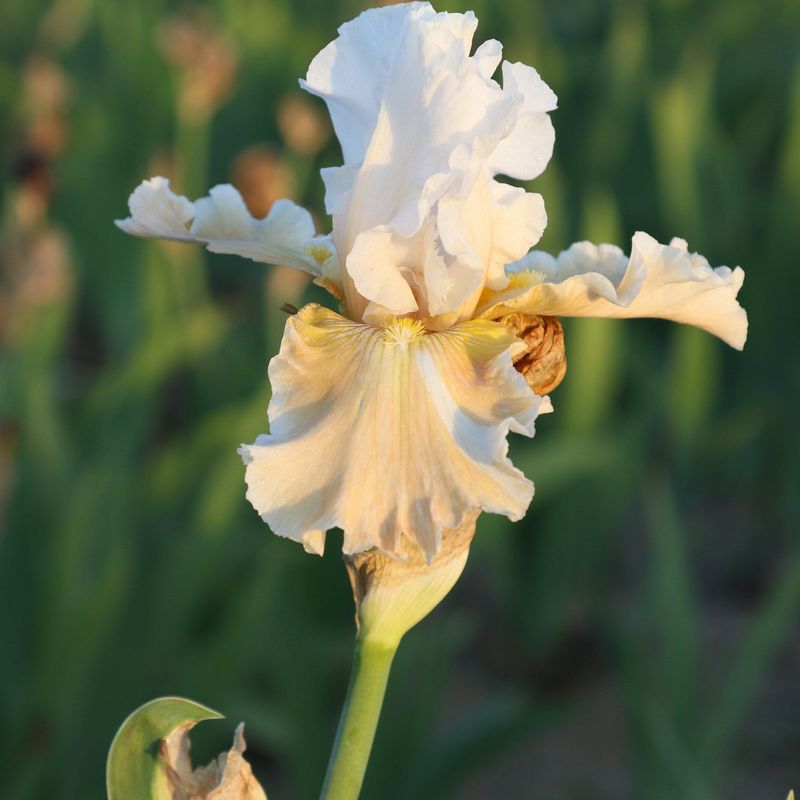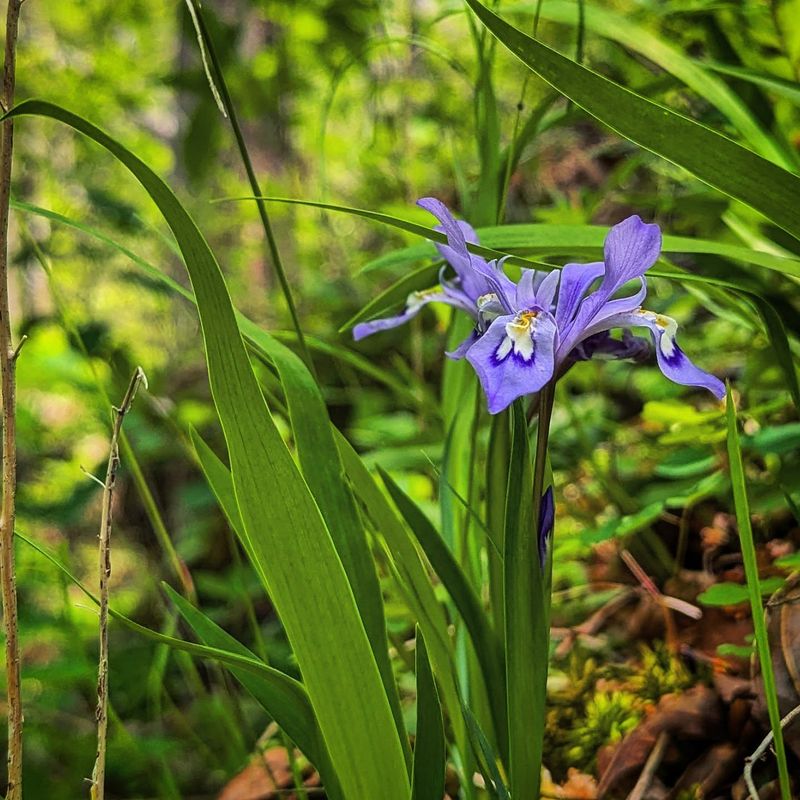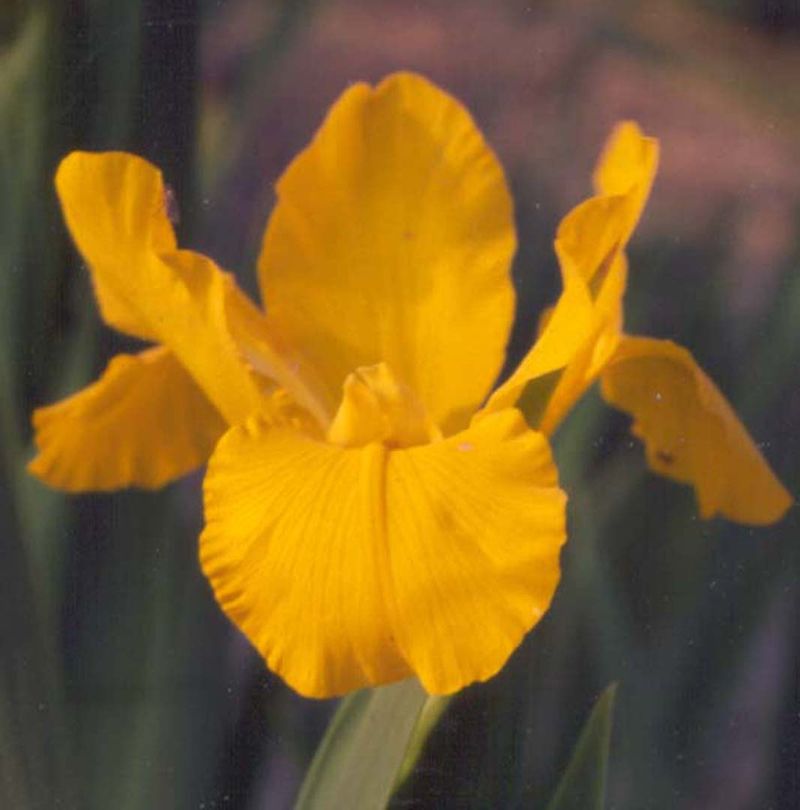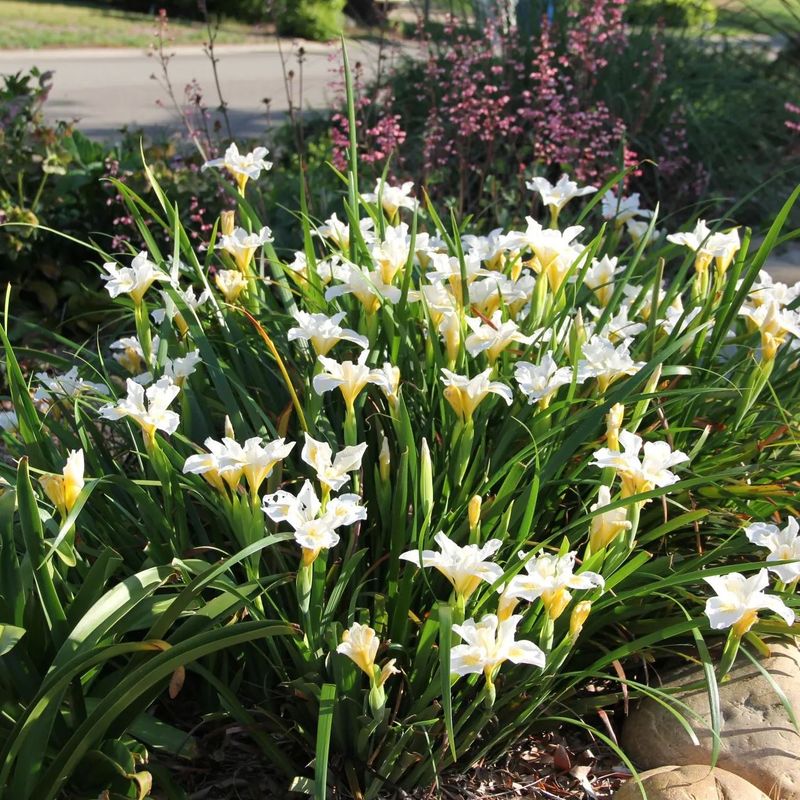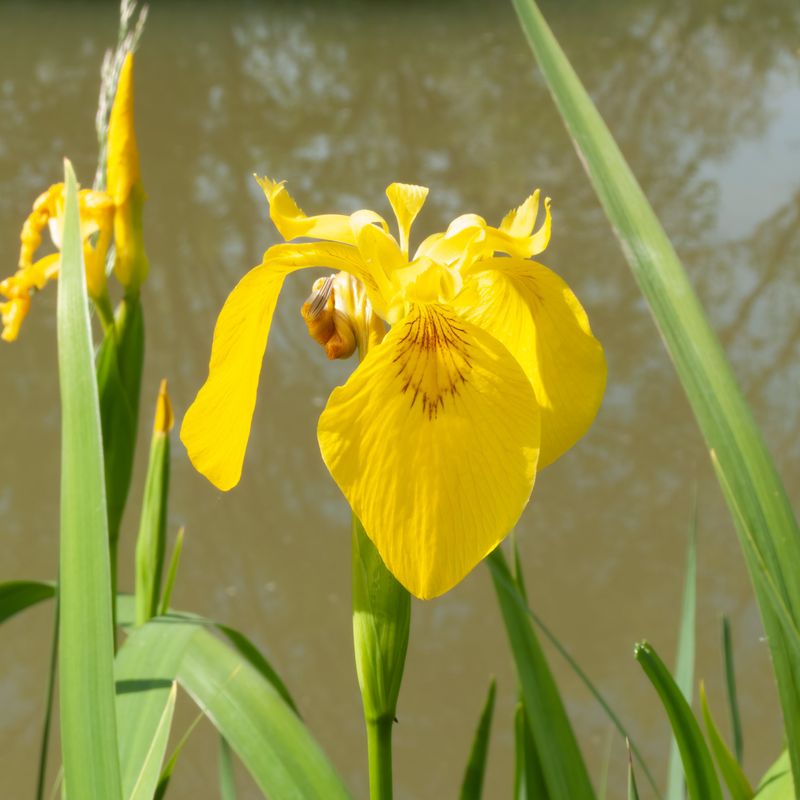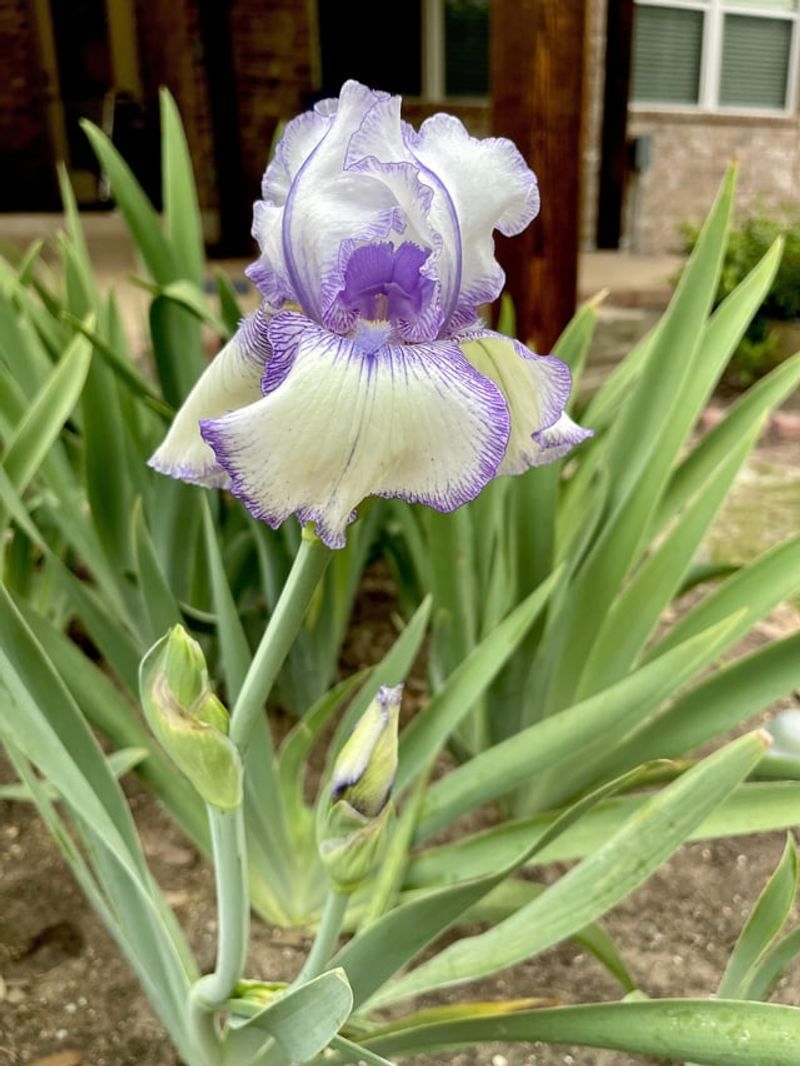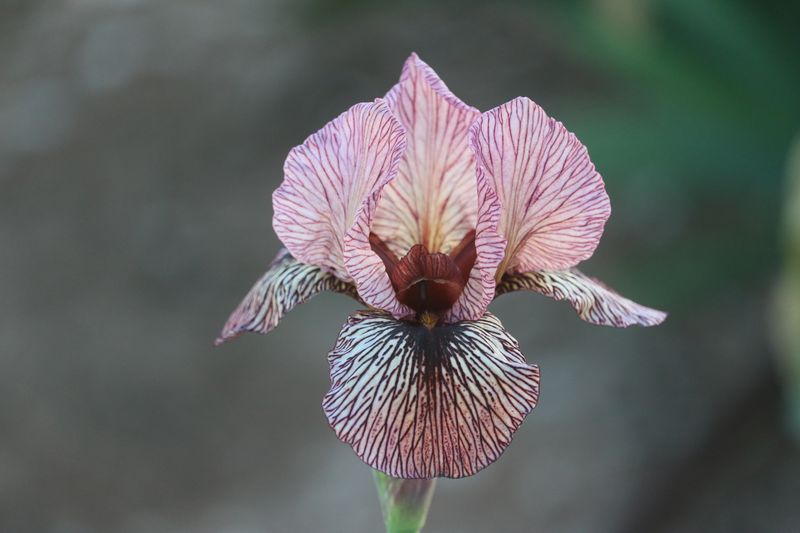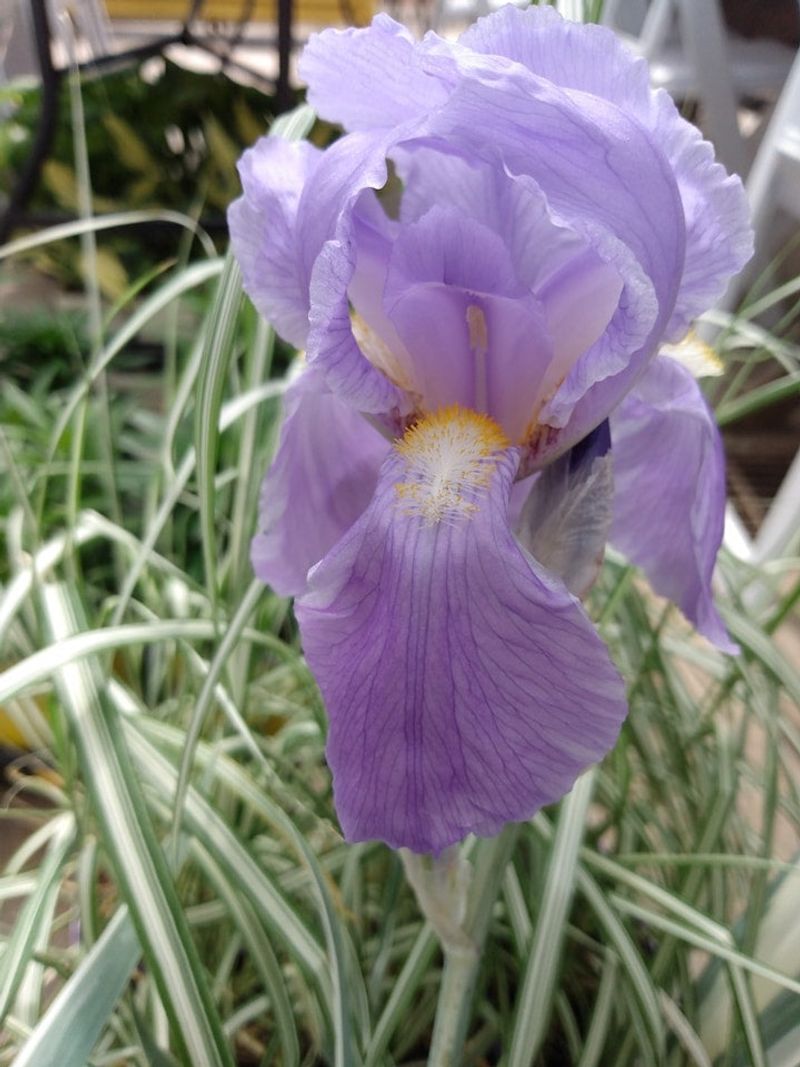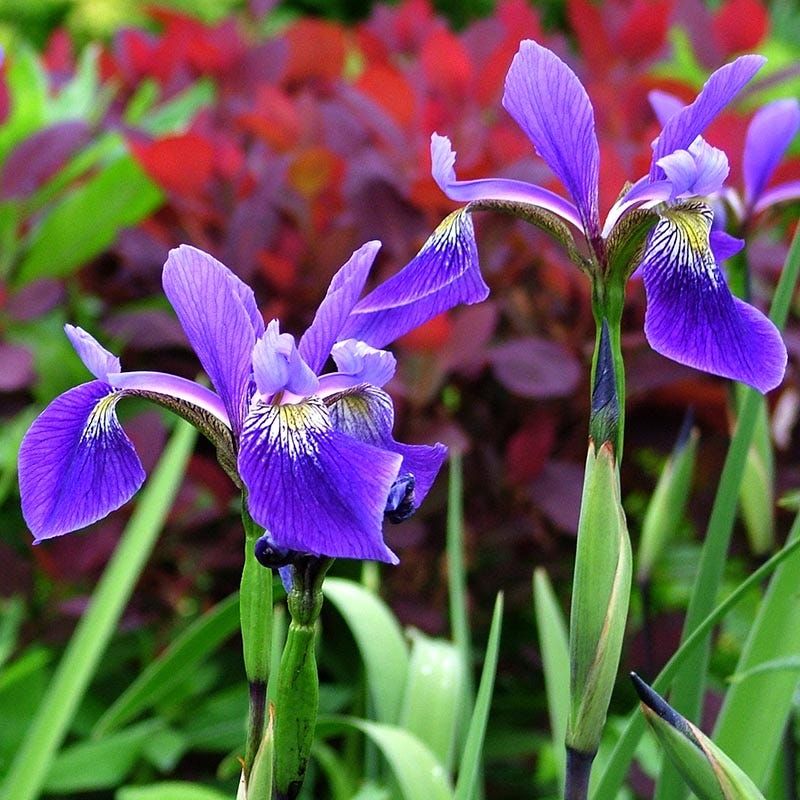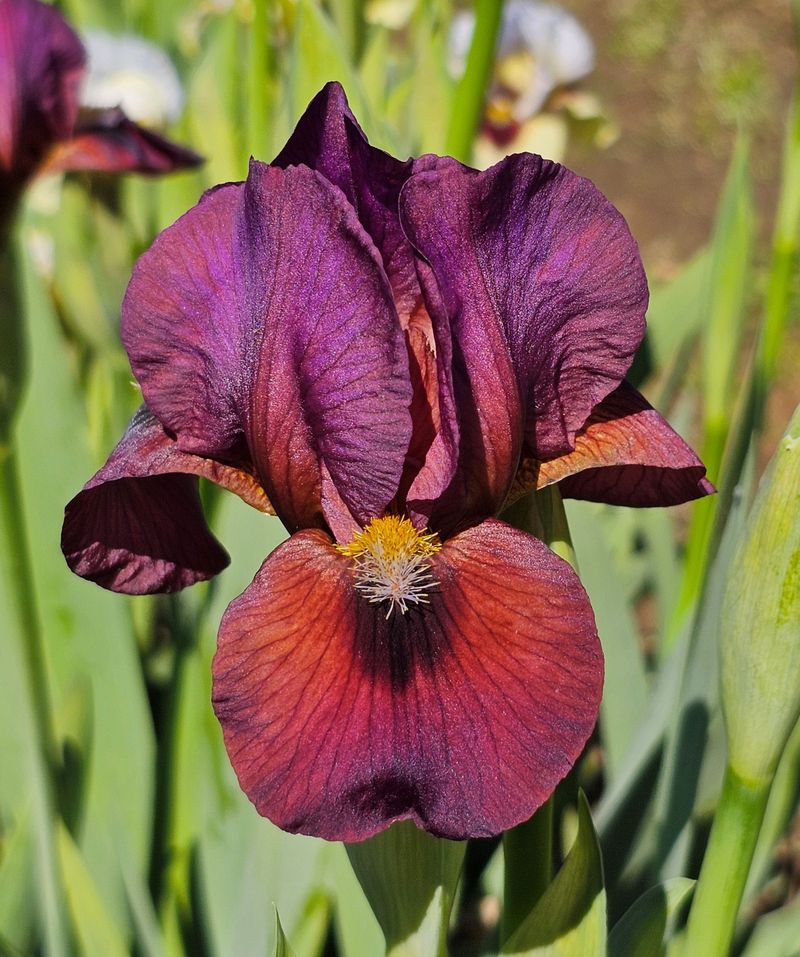Irises bring such a magical mix of color and grace to the garden—I look forward to their blooms every spring. Their elegant, ruffled petals and striking leaves make them feel almost regal. It’s no surprise they’re named after the Greek goddess of the rainbow.
What I love most is how many options there are, no matter where you garden. From dry, sunny spots to damp, shady corners, there’s an iris that can thrive there. They’re surprisingly tough for something that looks so delicate.
Whether you’re after bold, dramatic flowers or something to quietly complement your other perennials, irises fit right in. They’re beautiful on their own, but even better when thoughtfully paired. With so many varieties to choose from, it’s easy to find one that makes your garden truly shine.
1. Bearded Iris ‘Immortality’
Pure white petals with a faint yellow beard make this reblooming variety a standout in any garden. The fragrant blooms appear in spring, then surprise gardeners with a second show in fall when conditions are right.
Grows about 30 inches tall with sturdy stems that rarely need staking. I planted these along my driveway five years ago, and they’ve multiplied beautifully with almost no attention from me.
Tolerates clay soil better than most bearded varieties and performs well in zones 4-9. For best reblooming results, remove spent flower stalks promptly and provide a light feeding after spring flowering.
2. Siberian Iris ‘Caesar’s Brother’
Deep purple-blue flowers with velvety falls create a striking contrast against the slender, grass-like foliage. Unlike bearded varieties, these irises prefer slightly acidic, moist soil and will even tolerate wet feet during winter months.
The blooms appear in late spring after most bearded irises have finished. Last summer, I divided my decade-old clump and was amazed at how quickly the divisions established themselves.
Reaching 3-4 feet tall, they make excellent vertical accents in borders or near water features. The sturdy stems hold up well in rain and wind, making them reliable performers even in challenging weather.
3. Japanese Iris ‘Caprician Butterfly’
Enormous 6-inch blooms in lavender-blue with delicate white veining make this Japanese iris a showstopper in early summer. The flat, plate-like form distinguishes it from other iris types and creates a floating effect above the water.
Japanese irises demand consistent moisture and rich, acidic soil. My attempts to grow them in my alkaline garden failed until I created a special bed with amended soil and regular watering.
Plant these beauties at the edge of a pond or in a rain garden where they’ll receive plenty of moisture. They bloom about two weeks after Siberian irises, extending the iris season well into early summer with their spectacular display.
4. Louisiana Iris ‘Black Gamecock’
Velvety deep purple-black petals with a hint of gold signal create drama in wet garden areas. These native-derived irises bloom in late spring with 4-5 inch flowers that seem to float above the sword-like foliage.
Unlike many irises, Louisiana types prefer acidic, boggy conditions and even tolerate standing water. They’ve been the perfect solution for a persistently wet corner of my yard where little else would grow.
Hardy in zones 5-9, they go dormant in summer heat but return reliably each spring. The rhizomes should be planted just below the soil surface rather than exposed like bearded iris, and they appreciate a mulch layer to retain moisture.
5. Dutch Iris ‘Apollo’
Golden yellow standards contrast beautifully with the deep purple falls on this bulbous iris variety. Growing from true bulbs rather than rhizomes, Dutch irises bring early color to gardens and make exceptional cut flowers.
Plant the bulbs in fall for spring blooms that typically appear between tulips and bearded irises. After several disappointing attempts with other varieties, ‘Apollo’ has proven the most reliable returner in my zone 6 garden.
Reaching 18-24 inches tall, these irises need well-drained soil, especially during their summer dormancy. The narrow, reed-like foliage remains attractive until it yellows in early summer, when it can be trimmed back without harming next year’s bloom.
6. Bearded Iris ‘Batik’
Splashed and streaked with purple on white, each bloom of ‘Batik’ looks hand-painted and completely unique. This striking broken-color pattern results from a stable genetic trait, not disease, creating an artistic display in the late spring garden.
Growing to about 30 inches tall, ‘Batik’ performs like other tall bearded irises, preferring well-drained soil and full sun. The unusual coloration draws attention even from non-gardeners walking past my front yard.
Fragrant blooms appear in mid-spring and last about two weeks. For the best display, plant in groups of three or five rhizomes. They’ve proven quite drought-tolerant in my garden, requiring minimal supplemental water once established.
7. Iris reticulata ‘Harmony’
Brilliant blue-purple flowers with gold crests emerge just 4-6 inches tall in very early spring, often while snow still lingers nearby. These diminutive bulbous irises bloom alongside snowdrops and winter aconite, bringing the first true blue to the garden each year.
Plant bulbs in fall, choosing a spot with excellent drainage that receives spring sunshine. A south-facing slope near my driveway provides perfect conditions, where they’ve naturalized into charming drifts over the years.
After blooming, the narrow, grass-like foliage elongates and then disappears by early summer as the bulbs go dormant. They’re perfect for rock gardens, the front of borders, or naturalized in lawns where grass won’t be cut until their foliage ripens.
8. Bearded Iris ‘Champagne Elegance’
Soft peachy-pink standards meld into creamy falls with tangerine beards, creating a sunset effect in the garden. The large ruffled blooms emit a sweet fragrance that’s particularly noticeable in the evening hours.
Grows to about 36 inches tall with excellent branching that showcases multiple blooms at once. A late-season bloomer, it extends the iris display when many earlier varieties have finished.
The warm tones blend beautifully with roses and peonies that bloom simultaneously. I’ve found it performs better with afternoon shade in my hot southern garden, keeping the delicate colors from fading too quickly in intense sunlight.
9. Crested Iris (Iris cristata)
Native woodland charm comes in a 6-inch package with this diminutive North American species. Lavender-blue flowers with distinctive yellow or white crests appear in mid-spring above fan-shaped clusters of leaves.
Unlike most irises, this species prefers partial shade and humus-rich soil that stays evenly moist. The slowly spreading rhizomes create a lovely groundcover under deciduous trees where they receive spring sunlight before the canopy leafs out.
My patch started from just three small plants and now covers several square feet beneath a redbud tree. They’re deer-resistant and low-maintenance once established, needing only a light mulch of leaf compost each fall to mimic their natural woodland habitat.
10. Spuria Iris ‘Destination’
Elegant orchid-purple blooms perch atop 4-foot stems in early summer, well after most other irises have finished flowering. The distinctive form features falls that don’t droop downward but extend outward, creating a different silhouette from bearded types.
Spuria irises form clumps of narrow, upright foliage that remain attractive throughout the growing season. Unlike many irises, they dislike being divided and can sulk for a year or two afterward before resuming normal blooming.
Extremely drought-tolerant once established, these tough performers thrive in my hottest, driest border where they receive no supplemental water. They’re slow to establish but incredibly long-lived, with some clumps in my garden now entering their second decade.
11. Pacific Coast Iris ‘Canyon Snow’
Pristine white flowers with golden centers float just above the evergreen foliage of this West Coast native hybrid. The blooms appear in mid-spring on plants that rarely exceed 12-18 inches in height.
Demanding excellent drainage and neutral to acidic soil, these irises can be challenging outside their native range. After several failed attempts, I finally succeeded by planting them on a steep slope in a mix of native soil, grit, and composted pine bark.
Summer dormancy is natural for these irises, so don’t water heavily during hot weather. They prefer cool, moist winters and dry summers, making them ideal for Mediterranean climate gardens in zones 7-9 where they’ll form slowly expanding clumps of year-round interest.
12. Yellow Flag Iris (Iris pseudacorus)
Brilliant yellow blooms on 3-4 foot stalks make this water-loving species a standout in pond margins and rain gardens. The sword-like foliage creates vertical interest even when the plant isn’t flowering in late spring.
Caution is warranted when planting this vigorous species, as it can become invasive in ideal conditions. I keep mine contained in a large pot submerged at the edge of my small pond, which prevents unwanted spread while still providing the wet feet it craves.
Extremely adaptable to different light conditions, from full sun to partial shade. The robust rhizomes can help stabilize soil in erosion-prone areas, but always check local regulations before planting, as this iris is considered invasive in some regions.
13. Bearded Iris ‘Hemstitched’
Clean white petals edged with a precise purple picotee border create a crisp, tailored look in the spring garden. The pattern resembles fine needlework, giving this intermediate bearded iris its fitting name.
Growing to about 25 inches tall, ‘Hemstitched’ blooms in mid-season between the dwarf earlies and the tall late varieties. The moderate height makes it perfect for the middle of borders where it won’t overshadow smaller companions.
Exceptionally floriferous with multiple buds per stem, extending the bloom period to nearly three weeks. My clump struggled until I moved it from a partly shaded spot to full sun, where it now produces dozens of blooms each spring and increases rapidly.
14. Aril Iris ‘Oyez’
Exotic burgundy-veined falls with black signals below soft lavender standards create an almost otherworldly appearance. These unusual irises combine characteristics of bearded irises with species from arid Middle Eastern regions.
Requiring exceptional drainage and a dry summer rest period, they perform best in raised beds or rock gardens. My first attempts failed until I built a special bed with a gravel base and sandy soil mix specifically for these temperamental beauties.
Blooming in early to mid-spring on stems 12-18 inches tall, they appreciate protection from afternoon sun in hot climates. While challenging to grow, their unique patterns and colors make them collectors’ favorites and conversation starters when visitors spot them in my garden.
15. Iris pallida ‘Variegata’
Cream and green striped foliage creates year-round interest, while the classic lavender-blue flowers add a seasonal bonus in late spring. This ancient variety has been grown in gardens for centuries, valued as much for its decorative leaves as for its blooms.
The sword-like variegated foliage emerges early and remains attractive until frost, making it a structural anchor in perennial borders. When the winter sun hits the cream stripes just right, they seem to glow against the darker garden backdrop.
Extremely drought-tolerant and long-lived, my original plants have survived fifteen years of benign neglect. An added bonus is the sweet grape-like fragrance of the flowers, which intensifies in warm afternoon sun and can perfume an entire garden corner.
16. Beardless Iris ‘Gerald Darby’
Purple-tinted emerging foliage creates early spring interest before the violet-blue flowers appear. The dramatic purple coloration at the base of the leaves intensifies in cool spring weather, creating a striking effect even before blooming.
Growing 30-36 inches tall, this beardless hybrid thrives in moist, rich soil but adapts to average garden conditions better than many water-loving irises. The distinctive foliage color fades to green as summer progresses.
Blooms in late spring with elegant flowers that have a more wild, natural look than bearded varieties. My clump started small but has expanded steadily over five years, performing surprisingly well despite receiving less moisture than is typically recommended for this type.
17. Bearded Iris ‘Superstition’
Nearly black velvet falls and standards with a matching beard create a dramatic focal point unlike any other garden flower. The deep purple is so saturated it appears truly black except in bright sunlight, when subtle purple undertones become visible.
Blooming in mid to late season on 36-inch stems, ‘Superstition’ creates striking combinations with silver foliage plants or bright yellows. I’ve paired mine with golden Hakone grass, and the contrast stops garden visitors in their tracks.
The dark flowers hold up remarkably well in rain and hot weather without fading. Like most bearded irises, this variety appreciates having its rhizomes exposed to sunlight and performs best when divided every 3-4 years to maintain vigor.

